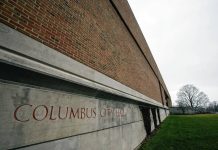Architectural and urban designer Paola Aguirre believes writing a love letter to the shuttered Crump Theatre could result in the decaying performance facility’s salvation.
Community residents are being asked to put their thoughts on paper in a special workshop from 2 to 4 p.m. Saturday at The Commons, and then translate those thoughts into colorful images that could be incorporated into an Exhibit Columbus installation at the theater this fall.
“It’s an exercise in translating narrative into a visual message,” Aguirre said in a telephone interview from her Borderless Studio and Workshop in Chicago recently. “I want people to consider writing a love letter to the Crump as though the building was a person.”
The Crump could use a little love. It has languished, albeit with basic maintenance, since early 2014 when the Columbus Fire Department ruled it could not reopen because of safety hazards involving fire dangers and other concerns.
[sc:text-divider text-divider-title=”Story continues below gallery” ]
Vacant for years and showing some decay, the 129-year-old facility was named this year to Indiana Landmarks 10 Most Endangered Structures list, even while it remains on the market by the Columbus Capital Foundation for a general price of $200,000.
For those who are thinking they couldn’t possibly write a love letter to a decaying building, Aguirre has already started the project with a group of 12 Columbus North High School students, who worked with Aguirre to take their words and assign feelings about those words with colors that eventually became graphics.
And those graphics will become part of a mosaic which will cover the east side of the Crump, where views will see it floating along the exterior wall as an “exterior curtain” during this fall’s Exhibit Columbus installations, she said. The graphic patterns are to be inspired by Alexander Girard’s urban and textile design practices.
The selection of student letters and art to begin the project was intentional, said Richard McCoy, director of the nonprofit Landmark Columbus that serves as the umbrella agency for Exhibit Columbus.
“The intention is to start with the next generation for the Crump,” McCoy said of the installation planned for the theater this fall. “We want to show how important their voices are in this project.”
About Exhibit Columbus
The Exhibit Columbus exhibition is a once-every-two-years display of a wide variety of temporary architectural installations meant to highlight or somehow connect to nearby, permanent structures and buildings in Columbus. The exhibition is set for Aug. 24 to Dec. 1, and is an exploration of art, architecture, and design.
Exhibit Columbus seeks to celebrate Columbus’ heritage while making it relevant in new and modern ways, according to organizers.
McCoy, who described Aguirre as a rising star in the architecture field, said the project is about creating a community that will come together through caring about what happens to The Crump.
That caring, in words, is what is behind the love letter part of the project, Aguirre said.
Participants are being asked to imagine the theater is a person and to tell the building why it matters, just as you would tell a person how much he or she matters.
“Why is its presence important for Columbus?” is one question Aguirre wants letter writers to answer about the building. “What do you want The Crump to become?”
The love letter should say something uplifting and meaningful — something you might say to a family member, according to the instructions Aguirre has with the project.
“The building has been fighting the good fight,” she said of its stately presence along Third Street, even while the Crump looks a little disheveled and untidy, but still holding up.
Following a color code relating to the past, present and future, participants will then take geometric shapes and artwork they create to make a letter-size square that will become part of the mosaic — translating words into visuals.
When the works are put together, they will form grids populated by different thoughts that continues to flow down the building, Aguirre said. The completed installation will be about 60 feet by about 30 feet on the side of the building, covering a metal area that currently covers the side there.
The designs will be reproduced on some sort of fabric currently being tested to withstand weather concerns and hold up during the exhibition, she said.
Space for the letters
While the written letters won’t be incorporated in the hanging artwork, Aguirre is thinking of a way to highlight them, too, perhaps printing them in a large digital poster format and placing them in the empty promotional frames in the front of the building, areas were movie and event posters were displayed.
Aguirre estimates she will need 40 to 60 of the graphic blocks — and individuals may want to create as many as four when they sit down to work on the process, which usually takes about an hour, she said.
In order to have enough materials, Aguirre is requesting individuals register in advance by Wednesday at the Love Letter for the Crump Facebook page which has a link to sign up.
The idea for the fluttering installation came from being inspired by the Crump’s curtains, Aguirre said.
“There’s something really beautiful about the textures inside this building,” Aguirre said of touring the interior before coming up with the idea for the outdoor installation. “The theatrical feel of it is still there.”
During visits to Columbus, she stops in at the Crump and in one of the visits was surprised to find the word “Crump” in terra cotta on the floor, something she found fascinating — prompting her to take a picture of it that she keeps on her phone.
And in the process of dreaming up an Exhibit Columbus installation for The Crump, Aguirre allows that she’s also fallen a little in love with Columbus in her travels here.
“I love the scale of the city — it’s quite a contrast to Chicago — everyone knows each other here and that’s really powerful,” she said.
She’s also impressed with Columbus’ planning efforts for the downtown and that the city knows the theater has to be part of the revitalization plan.
“I’m a big believer in incremental interventions — and finding out how you awaken a sleeping asset,” she said.
And the Crump’s famed art deco decor, which is a little bit out of place in Columbus’ mid-century Modern heritage, is part of the Crump’s charm, she said.
“I just started falling in love with the city and with the Crump,” she said. “I’m excited to see if other people will as well.”
[sc:pullout-title pullout-title=”How to register for the event” ][sc:pullout-text-begin]
What: Love Letter to The Crump
When: 2 to 4 p.m. Saturday
Where: The Commons, 300 Washington St.
How to register: To register for the Love Letter to the Crump event, visit the event’s Facebook page at facebook.com/events/366412277304541/ and click on the eventbrite link to make a reservation. Organizers are asking for reservations to be made by Wednesday.
[sc:pullout-text-end][sc:pullout-title pullout-title=”About the Crump” ][sc:pullout-text-begin]
Built in 1889 as a theater at 425 Third St., the hall — which once seated 632 people — is known for its Art Deco-style lobby and a stage that has a history of well-known performers. Those who once graced the Crump’s stage range from John Phillip Souza to Seymour native John Mellencamp, who performed Sept. 23, 2008, in a benefit concert for Columbus flood relief.
But in early 2014, the city fire department wouldn’t allow the theater to reopen after safety hazards were revealed. Those hazards included a lack of a fire sprinkler system and functioning fire escapes, a stage floor that doesn’t meet structural codes and a water-damaged mechanical room considered to be unsafe.
Location: 425 Third St.
Owner: Columbus Capital Foundation purchased the Crump Theatre in 1994 on behalf of Historic Columbus Development. The nonprofit foundation was established to support The Heritage Fund — The Community Foundation of Bartholomew County, the city of Columbus and Bartholomew County by preserving and maintaining land and buildings that have historic or architectural significance.
Current status: Closed. Listed for sale by the foundation.
[sc:pullout-text-end][sc:pullout-title pullout-title=”Historical highlights” ][sc:pullout-text-begin]
Early 1870s: Building constructed by attorney John A. Keith. Contains a dining hall, offices for doctors, dentists and lawyers and a small auditorium in the rear.
1879: Purchased by John S. Crump for $6,000. Building is rebuilt and remodeled to a 2,000-seat opera house
Oct. 30, 1889: Opens for a performance of “The Pretty Persian.”
May 6, 1914: First movie reels begin showing, including a short series of silent films about the Panama Canal.
Dec. 30, 1931: Theater purchased by Mr. and Mrs. Louis Holwager of Madison.
Feb. 7, 1934: Syndicated Theaters signs a 10-year lease to show movies.
April 26, 1935: Marquee remodeling begins.
April 2, 1949: Syndicated Theaters Inc. purchases theater for $150,000.
March 16, 1962: Theater is purchased by Margrat Inc. of Franklin.
Dec. 17, 1978: Fire in nearby building causes smoke damage in the theater.
April 13, 1994: Columbus Capital Foundation Inc. buys property on behalf of Historic Columbus Development.
March 1995: “Save the Crump” community fund drive begins, raising $115,000 to complete basic repairs. Theater reopens in December 1995 to show $1 movies.
Sept. 23, 2008: John Mellencamp performs a benefit concert in the theater, recorded for the Arts and Entertainment Biography channel.
Dec. 31, 2013: Final event, a New Year’s Eve party, is held before the theater closed in January 2014.
March 2014: City of Columbus inspectors order the theater to remain closed because of safety hazards including lack of a fire sprinkler system, lack of functioning fire escapes, a stage floor that does not meet structural codes and a water-damaged mechanical room.
Summer 2016: The theater’s exterior and lit marquee are used during the filming of the movie “Columbus,” but the scenes are not included in the finished movie.
April 2019: The 129-year-old theater is named to Indiana Landmarks 10 most Endangered structures list. The theater has been for sale since 2015, with the Columbus Capital Foundation setting a general price of $200,000.
[sc:pullout-text-end][sc:pullout-title pullout-title=”About Borderless Studio and Paola Aguirre” ][sc:pullout-text-begin]
Paola Aguirre is an architectural and urban designer with professional experience working with government, universities and private firms in the United States and Mexico.
Her work has included collaborations with University of Chicago’s Place Lab, City Design Practice at Skidmore, Owings & Merrill in Chicago, New York University’s Office of Strategic Assessment, Planning & Design and the Municipal Institute of Planning of Chihuahua.
Borderless Studio is an urban design and research consultancy focused on shaping communities through collaborative design. Based in Chicago and led by Aguirre, it explores comprehensive city design solutions addressing complex urban systems and equitable development with emphasis on research and communication across disciplines.
Borderless leads Creative Grounds, an initiative responding to Chicago’s school closures, aimed at starting a conversation about the future of the city’s social infrastructure.
[sc:pullout-text-end][sc:pullout-title pullout-title=”Where to learn more” ][sc:pullout-text-begin]
To learn more about the Crump love letter project, visit borderless-studio.com/love-letter-to-the-crump.
To learn more about Exhibit Columbus, visit exhibitcolumbus.org.
[sc:pullout-text-end]




